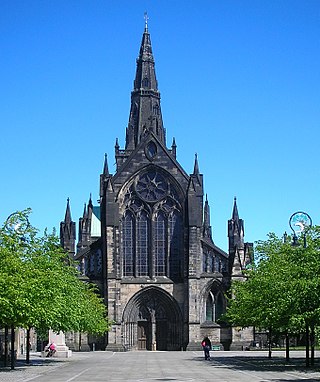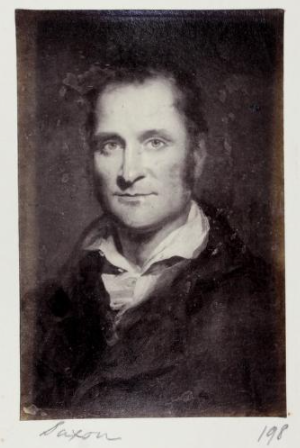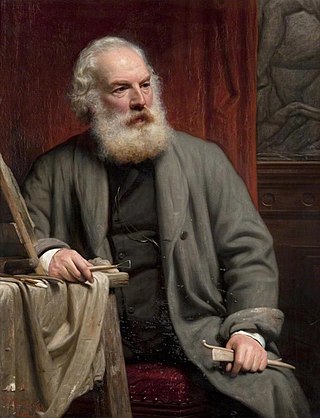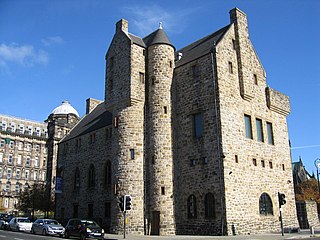
George Square is the principal civic square in the city of Glasgow, Scotland. It is one of six squares in the city centre, the others being Cathedral Square, St Andrew's Square, St Enoch Square, Royal Exchange Square, and Blythswood Square on Blythswood Hill.

Glasgow Cathedral is a parish church of the Church of Scotland in Glasgow, Scotland. It is the oldest cathedral in mainland Scotland and the oldest building in Glasgow. The cathedral was the seat of the Archbishop of Glasgow, and the mother church of the Archdiocese of Glasgow and the province of Glasgow, until the Scottish Reformation in the 16th century. Glasgow Cathedral and St Magnus Cathedral in Orkney are the only medieval cathedrals in Scotland to have survived the Reformation virtually intact. The medieval Bishop's Castle stood to the west of the cathedral until 1789. Although notionally it lies within the Townhead area of the city, the Cathedral grounds and the neighboring Necropolis are considered to be their own district within the city.

Townhead is a district within the city of Glasgow, Scotland. It is one of Glasgow's oldest areas, and contains two of its major surviving medieval landmarks – Glasgow Cathedral and the Provand's Lordship.

James Pittendrigh MacGillivray was a Scottish sculptor. He was also a keen artist, musician and poet. He was born in Inverurie, Aberdeenshire, the son of a sculptor, and studied under William Brodie and John Mossman. His works include public statues of Robert Burns in Irvine, Lord Byron in Aberdeen, the 3rd Marquess of Bute in Cardiff, John Knox in Edinburgh's St Giles Cathedral, and William Ewart Gladstone in Coates Crescent Gardens, Edinburgh.

David Hamilton was a Scottish architect based in Glasgow. He has been called the "father of the profession" in Glasgow.

The Citizens Theatre, in what was the Royal Princess's Theatre, is the creation of James Bridie and playwright in residence Paul Vincent Carroll is based in Glasgow, Scotland, as a principal producing theatre. The theatre includes a 500-seat Main Auditorium, and has also included various studio theatres over time.

John G. Mossman was one of a number of English sculptors who dominated the production and teaching of sculpture in Glasgow for 50 years after his arrival with his father and brothers from his native London in 1828. His father William Mossman (1793–1851) was also a sculptor, and a pupil of Sir Francis Chantrey. He was trained both by his father and under Carlo Marochetti in London.

The Glasgow Necropolis is a Victorian cemetery in Glasgow, Scotland. It is on a low but very prominent hill to the east of Glasgow Cathedral. Fifty thousand individuals have been buried here. Typical for the period, only a small percentage are named on monuments and not every grave has a stone. Approximately 3,500 monuments exist here.

The St Mungo Museum of Religious Life and Art is a museum of religion in Glasgow, Scotland. It has been described as the only public museum in the world devoted solely to this subject, although other notable museums of this kind are the State Museum of the History of Religion in St. Petersburg and the Catharijneconvent in Utrecht.
Blythswood Hill, crowned by Blythswood Square, is an area of central Glasgow, Scotland. Its grid of streets extend from the length of the west side of Buchanan Street to Gordon Street and Bothwell Street, and to Charing Cross, Sauchiehall Street and Garnethill. Developed from 1800 onwards, its Georgian and Victorian architecture is a Conservation Area. It started as the "Magnificent New Town of Blythswood", becoming a part of the city-centre's business and social life.
John Burnet was a Scottish architect who lived and practised in Glasgow. He was born the son of militia officer and trained initially as a carpenter, before becoming a Clerk of Works. He rose to prominence in the mid-1850s.

Glasgow Cross is at the hub of the ancient royal burgh and now city of Glasgow, Scotland, close to its first crossing over the River Clyde. It marks the notional boundary between the city centre and the East End

The Royal Exchange Square is a public square in Glasgow, Scotland. The square lies between Buchanan Street and Queen Street, opening out Queen Street and Ingram Street to the south of George Square. It is also easily accessible from Buchanan Street on the west side of the square, through two prominent archways at Royal Bank Place. The square is a landmark due to its distinguished architecture which attracts many visitors. It is one of six squares in the city centre.

William Shirreffs was a Scottish sculptor in the 19th century.
William Mossman was a Scottish sculptor operational in the early 19th century, and father to three sculptor sons.

Thomas Gildard was a 19th-century Scottish architect and author. In a short career as a private architect alongside Robert Macfarlane, before entering public service as deputy to Glasgow`s Master of Works, buildings designed by him and his professional partner are : the Clyde Thread Works, also known as Clyde Thread Mills; Belgrave Terrace on the southside of Great Western Road, Glasgow; Ardenvhor fronting the Gareloch; and in 1857/58 an Italianate warehouse in the Trongate, Glasgow for Archibald Blair, two floors of which opened on 25 December 1859 as the Britannia Music Hall.

The Barony Hall,, is a deconsecrated church building located on Castle Street in the Townhead area of Glasgow, Scotland, near Glasgow Cathedral, Glasgow Royal Infirmary and the city's oldest surviving house, Provand's Lordship. It is built in the red sandstone Victorian neo-Gothic-style. The original or Old Barony Church was built as a part of the Barony Parish in Glasgow by architect, James Adams. It opened in 1799 and served ceremonial and other congregational purposes. The replacement for the old building was designed by J. J. Burnet & J. A. Campbell and raised in 1889, and incorporated architectural artifacts from the old church and a number of other relics.

John Honeyman was a Scottish architect. He designed several notable buildings in Scotland, mostly churches, and worked alongside Charles Rennie Mackintosh as a partner for several years.
Etheldreda (Dreda) Holstein Boyd (1879–1975) was a writer and antiquarian from Glasgow. She was one of the first female members of the Old Glasgow Club.























